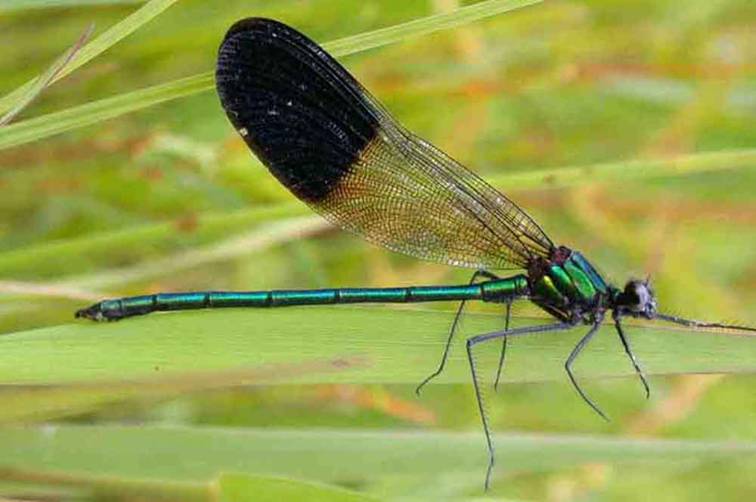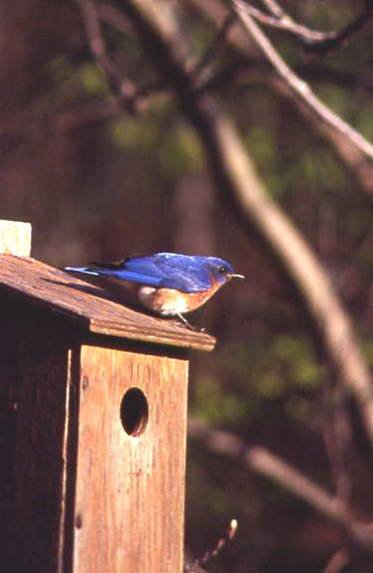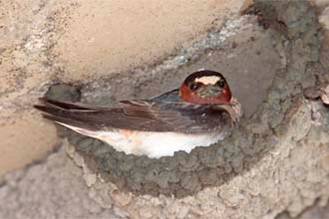My research interests are in the
field of behavioral ecology, and in particular I am interested in
how ecological factors influence territoriality, mating systems and
reproductive strategies. Although I am not currently conducting new
research, some of my past projects are described below.
Calopteryx aequabilis damselflies

Three species of
Calopteryx damselflies live in Nova Scotia. Males defend patches
of aquatic vegetation that females use to lay their eggs in, and
males use elaborate courtship displays to attract females. When male
territories were experimentally manipulated to increase or decrease
these resources, male territorial behaviour changed in response to
resource quality. Males with large vegetation patches spent more
time defending their territories, and less time guarding their mates
during oviposition.
Eastern Bluebirds


Eastern Bluebirds
have a socially monogamous mating system, that appears to be
maintained by a need for male parental care. Experiments showed that
females raising young without male help raised fewer young than
pairs of birds. A DNA fingerprinting study showed that about 24% of
nests contained at least one nestling fathered by a male other than
the care-giving mate. Male eastern bluebirds used mate guarding
behaviour to protect their paternity, and there was a tradeoff
between mate guarding and territory defense.
Cliff Swallows

I examined whether cliff swallows avoid settling near to each other
or prefer to nest in close proximity. Male Cliff Swallows occupied
and defended nests before females paired with them, and males
settled next to other males significantly more often than expected
by chance. In contrast, female settlement was not significantly
different from random: females neither preferred nor avoided
settling next to other Cliff Swallows. Nest sites are in short
supply, and nests must be constantly guarded in order to prevent
usurpation. As a result, male cliff swallows use frequent
copulations rather than mate guarding to protect their paternity.
PUBLICATIONS
Meek, S.B. & Barclay, R.M.R. 1996. Settlement patterns and nest site
selection of cliff swallows Hirundo pyrrhonota: males prefer
to clump but females settle randomly. Can. J. Zool. 74:1394-1401.
Meek, S.B. & Robertson, R.J. 1995. Time of day of egg laying by
Eastern Bluebirds (Sialia sialis). Wilson Bull. 107:298-303.
Meek, S.B., Robertson, R.J. & Boag, P.T. 1994.
Extrapair paternity and intraspecific brood parasitism in Eastern
Bluebirds revealed by DNA fingerprinting. Auk 111:739-744.
Meek, S.B. & Robertson, R.J.
1994. Effects of male removal on the behaviour and reproductive
success of female Eastern Bluebirds Sialia sialis.
Ibis 136:305-312.
Meek, S.B. & Robertson, R.J.
1994.
Interspecific competition for nestboxes affects mate guarding in
eastern bluebirds, Sialia sialis.
Anim. Behav. .
47:295-302.
Meek, S.B. & Robertson, R.J. 1992. How do floater male eastern
bluebirds benefit by filling vacancies on territories where females
already have young? Behav. Ecol. 3:95-101.
Meek, S.B. & Robertson, R.J. 1991. Adoption of young by replacement
male birds: an experimental study of eastern bluebirds and a review.
Anim. Behav. 42:813-820.

